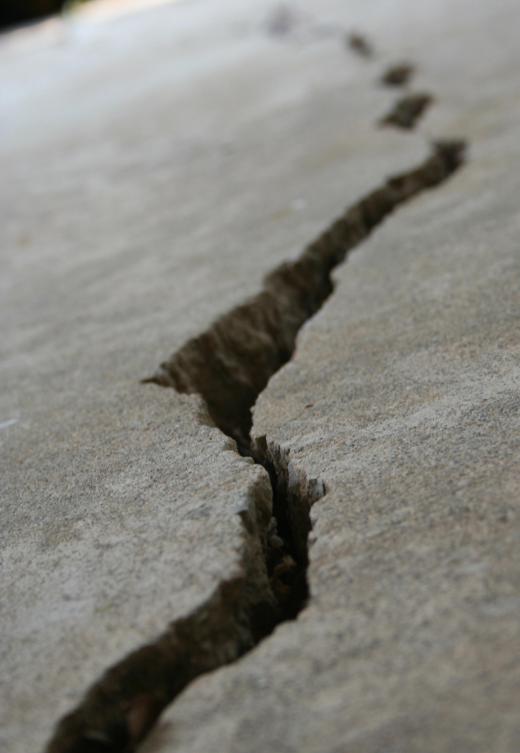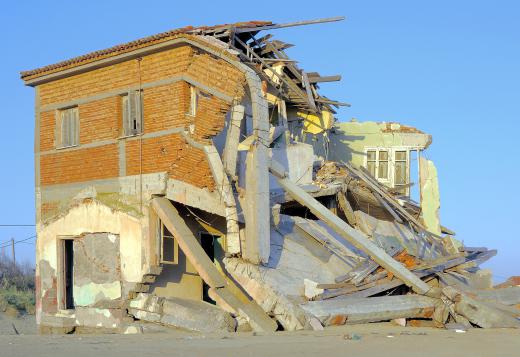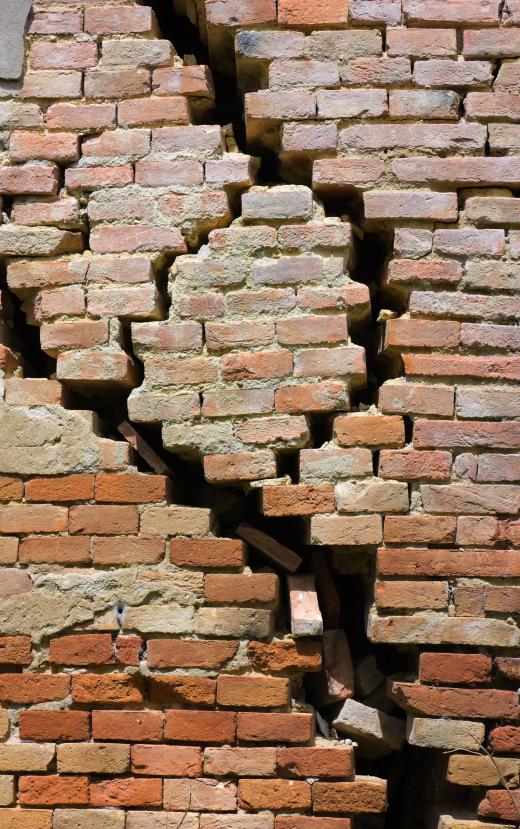What are Earthquakes?
 Mary McMahon
Mary McMahon
An earthquake is a tremor in the Earth's crust, caused by movements below its surface. These events can vary widely in intensity, from seismic activity that is barely detectable using sophisticated devices, to devastating temblors that can level cities and trigger tsunamis and sometimes even volcanic activity. The study of these tremors is known as seismology, a word derived from a Greek word meaning “to shake.”
The Earth's outer layer, or crust, is composed of two sections: the lithosphere, a Greek word meaning “rocky sphere,” and the athenosphere, a thick layer of liquid that rests on top of the upper mantle. The liquid rock of the upper mantle keeps the crust in constant motion, with the edges of continental plates being pulled slowly apart or together as they float on the athenosphere. The movement of these plates is what triggers earthquakes. In addition to plate boundaries, temblors also occur along faults, cracks in the lithosphere caused by the stresses created as tectonic plates move.

There are a number of different types of faults, but most can be divided into three categories: strike slip faults, thrust faults, and normal faults. A strike slip fault occurs in an area where two plates are sliding past each other, while a thrust fault happens when plates are being pushed together. A normal fault is the result of plates being pulled apart. The largest normal faults in the world are along the deep sea ocean ridges of the Pacific and Atlantic, where plates are pulling apart, crashing into the continental plates and causing thrust faults. Earthquakes along each fault have different characteristics that help seismologists to identify them.

The roots of a quake lie in stresses placed on the lithosphere as it drifts on the surface of the Earth. Pressure builds up along a fault line, which finally fails, often deep below the crust of the Earth, in an area called the focus. The corresponding spot on the surface of the planet is called the epicenter, and usually the greatest concentration of damage occurs here. When the fault fails, it triggers seismic waves, very low frequency sound waves that come in several shapes, and which can cause the earth to ripple, heave, buckle, or tear apart. The waves can continue for hours after the earthquake was triggered, and aftershocks, further smaller tremors, can continue for months and possibly even years later.

The intensity of an earthquake is called its magnitude. Various scales were proposed to measure this factor until 1935, when the Richter scale was developed. Under this scale, each order of magnitude is 10 times more intensive than the last. A quake that measure a 2 on the Richter scale is 10 times more intense than a 1, while a 3 is 100 times greater. Most quakes around the world are below a 4.5, the magnitude at which it can start to damage buildings, and every year there is at least one greater than an 8, with the largest modern earthquake ever recorded occurring in Chile in 1960; it measured a 9.5.
AS FEATURED ON:
AS FEATURED ON:















Discussion Comments
I was in an earthquakes once. My family and I were on a military base in the Middle East and we were actually staying at the hotel there. One morning at like four or five a.m., I woke up with my bed shaking from left to right. The entire walls of the hotel were going back and forth.
My initial response was to run. I wasn't even thinking, I just started running but then my mother stopped me and told me to stay put because we were on the 11th floor and the elevators weren't working. So I grasped my bed, closed my eyes and started praying. It was so scary!
After about thirty seconds which seemed like minutes, the shaking stopped. Thank God we were in a safe building that was built to withstand earthquakes. I can't imagine what would have happened if the building had collapsed.
Can someone explain to me in simple terms why earthquakes today seem to happen in always the same places?
Is there something about the tectonic plates in these areas that make it more prone to earthquakes? I'm confused about this.
@succulents-- Yea, that's true. Earthquakes have always been taking place but in the past, people in different geographic regions weren't aware of earthquakes in other places. Now, we hear about all earthquakes that happen anywhere in the world.
In a way, it's good because we can give financial aid to countries who experience major earthquakes that damage infrastructure and kill people. At the same time, I think we realize how unstable and scary mother nature can be.
@Georgesplane- I am not a geology expert, but I have taken a few geology courses. Considering the recent earthquake off the eastern coast of japan, I know that this was an abnormally large earthquake for the region. They expected large quake in this region is somewhere in the low 8.0s on the moment magnitude scale. Having an 8.9-9.1 (depending on the source) occur is about 20 times larger than what is expected. The reason that these quakes are so large in this region is because of the jagged nature of the fault created by the pacific plate subducting beneath Japan.
As for the abnormality of earthquakes of this intensity, I read something from the USGS last year that stated the number and magnitude of earthquakes has been historically consistent. Maybe that has changed since then, but the report included the quake in Haiti Chile.
The earthquake in Japan will certainly go down as one of the most famous earthquakes. Especially considering it will renew doubts about nuclear energy in an era of energy insecurity. What I want to know is how common are these large earthquakes? As succulents stated, we are much more aware of international events because of the 24-hour news cycle, but is it this common to have so many huge earthquakes at once? Do earthquakes come in waves as one part of a plate shifts causing a geologic chain reaction that causes earthquakes around the entire tectonic plate?
There seems to have been a lot of big earthquakes lately. I know with how media coverage has become almost all-encompassing, that we are aware of far more things than ever before. But between the very large Haiti and Chile earthquakes and the crazy weather, it sure seems like things are changing.
It really makes me worry about the coming hurricane season.
Post your comments